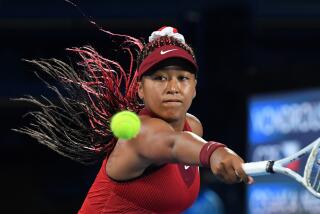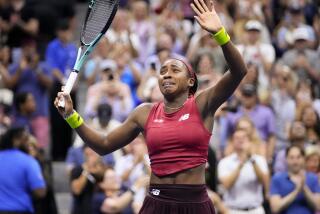Graf, 16, Can Handle Pressure
- Share via
PARIS — Steffi Graf was sitting in the players lounge at Roland Garros Stadium, fidgeting slightly as she answered questions. “All the time I am asked the same ones,” she said without a trace of rancor. “I try to think of different answers.”
Looking up, Graf saw the hairdresser for the women’s tennis tour approaching. “Today, you cut your hair, Steffi?” Graf was solemn now. “I don’t think I have time,” she said, politely. Her layered, shoulder-length blond hair looks just fine. But the woman was persistent. “Please, please,” she implored.
“I’ll try,” Graf finally said. The hairdresser left, delighted.
“In juniors,” Graf said, “I always had fun. Everything was fun. Now most of the fun is on the tennis court. It’s not as much fun outside the court now.”
Steffi Graf will be 17 in two weeks. She is the No. 3-ranked women’s tennis player in the world. She should succeed Martina Navratilova and Chris Evert Lloyd as the best.
And now everyone wants some of Steffi Graf. Her father, who taught her the game. Her agent, who is helping make her rich. The media. Hairdressers. All of West Germany.
Graf thinks she can handle the pressure.
“I have a great life,” she said. Her face lit up again. She seemed to mean it.
How good is Graf? In the last decade, challengers to Lloyd and Navratilova have come and gone. Tracy Austin. Andrea Jaeger. Pam Shriver. Manuela Maleeva. Hana Mandlikova.
All have had moments. A victory here and there. But none have ascended the throne. Injuries, burnout or lost motivation, along with the toughness of Navratilova and Lloyd, have prevented them from overtaking the monarchs.
Barring catastrophic injury, Graf should finally do that. She is here at the right time. She has the talent, the mental attitude and--it seems--the protection from burnout so many teen sensations have lacked in the past.
“She’s so mature, that’s what you notice about her first,” Navratilova said. “She’s really a fighter on the court. When she gets down, she doesn’t pout or give up. She tries to adjust, to find a way. I think that says a lot about her. She’s got the shots and she’s tough mentally.”
Ever since her father, Peter Graf, sawed off the handle of a racket when Graf was 4 so she could hold it, Graf has been a star. She dominated her age groups and turned pro at 13. Unlike Gabriela Sabatini, 11 months her junior, Graf did not burst onto the tour overnight. She has been out for four years now, rising steadily.
Certainly, she has been pushed. Peter Graf is a short, stern man who wants big things for his daughter. He has been given a penalty point once this year in a tournament for coaching from the stands and is never far away when his daughter is playing, practicing, talking or endorsing.
Graf’s amazing 23-match winning streak was broken just last week by Mandlikova. Earlier, she had won four straight tournaments.
In April, she beat Lloyd for the first time in the final at Hilton Head, S.C. Two weeks ago, she beat Navratilova for the first time, in the final at West Berlin. Both victories were in straight sets.
Because of the publicized burnout cases of Austin and Jaeger, everyone worries about keeping the pressure off young phenoms. Graf is no exception. Peter Graf has been compared by some to Roland Jaeger, whose temperament, some people believe, drove his daughter out of tennis. But it was Graf who made his daughter take three months off at the end of last year after she had reached the semifinals at the U.S. Open.
Graf has managed so far to play tennis like a woman and still find some time to play off the court like a girl. After she beat Navratilova, Graf went home to Bruehl, a small town in southern Germany for a couple of days. What did she do?
“Played basketball,” she said laughing. On her first off day here, what did she do? “It was hot and beautiful so I went for a swim.” Tennis prodigies aren’t supposed to risk their bodies playing basketball. Graf once broke her left pinky playing the game, but she still plays.
Graf has an extraordinary forehand, the kind that pins people in the corners of the court. Her backhand is improving. If she learns to volley, she will be unbeatable.
“It’s all confidence,” said JoAnne Russell, who has been on tour throughout the Lloyd-Navratilova era. “Right now, she thinks she can hit any shot. When someone who is good to start with is feeling that way, they’re almost impossible to beat. She’s ready for anyone.”
Graf says she feels differently about Lloyd-Navratilova now. “Last year, I just wanted a chance to play them,” she said. “Now, when I play them, I think I have a chance. It’s a good feeling. It just surprises me. It’s all come so fast.”
Remarkably fast. When Graf beat Navratilova, she drubbed her, 6-2, 6-3, in 64 minutes. During the awards ceremony, Navratilova cried. She said later it was because she was unhappy that her family could not be in West Berlin that day. Everyone else thought she was crying because of the magnitude of the defeat.
“I felt so bad about it but I didn’t know what to do,” Graf said. “When we walked off I said to her, ‘The next time will be your turn.’ ”
Graf’s arrival as a star is perfectly timed. Not only is it inevitable that Navratilova-Lloyd will finally begin to fade as they head into their 30s, but Boris Becker exists.
If there was no Becker, Graf would be West Germany’s reigning tennis idol right now. But because Becker won Wimbledon last year, he is the German hero. Graf has been able to work her way up through the women’s rankings with a minimum of fanfare.
“I think I’ve been lucky,” Graf said. “Because of Boris there’s not been so much attention on me and I like that. I don’t mind doing the things I’m asked to but I wouldn’t want too much. Right now, I still have my free time and my fun.”
“What’s amazing about Steffi is her consistency,” said Phil dePicciotto, her agent. “When we were looking at her age group a couple years ago we made a conscious decision to try to sign her over Sabatini, not because we didn’t think Sabatini was very good but because we thought Steffi was going to be the one. I think we were right.”
Interestingly, Graf and Sabatini have been playing doubles together recently. They spend a lot of time with their families and their agents and there is some resentment among the other women because Graf and Sabatini are so good.
Graf seems unbothered, at least for now, by all this. She is just playing tennis and having fun. She didn’t expect to be so good so soon. “When I played Chris at Hilton Head, I never thought I could win,” she said. “I was playing badly before the match, even when I warmed up. But then when we started I think Chris was a little nervous. I won the first set and I was so excited I lost my concentration.”
While Graf was celebrating, Lloyd jumped to a 4-0 lead in the second set, but Graf started blasting winners all over the court and came back to win the set, 7-5, and the match.
Lloyd said she learned a lesson from her loss. Navratilova said the same thing after Graf beat her. Time will tell. But her time is coming.
“I don’t think I’ve realized that I’m No. 3 yet,” Graf said. “I’m just out playing. I don’t worry about those things. I have lots of time to play tennis.”
Sometime soon--days, weeks, months at most--Steffi Graf will play tennis better than any woman in the world. “I don’t think about that,” she said. “You can get hurt, you can lose your confidence, you can get tired of tennis. It’s happened to people before.”
Could it happen to Steffi Graf? The smile faded. The answer was firm: “No. Not me.”
More to Read
Go beyond the scoreboard
Get the latest on L.A.'s teams in the daily Sports Report newsletter.
You may occasionally receive promotional content from the Los Angeles Times.










